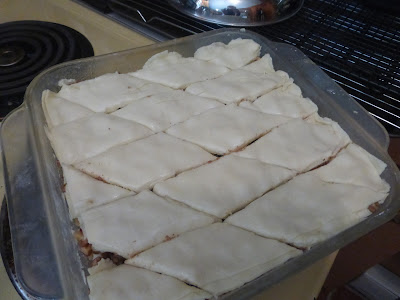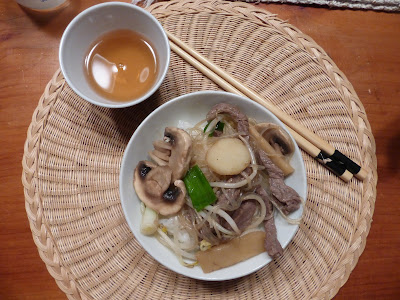We are moving on to Europe!
(Yes, alphabetically we're doing Europe next. We're grouping Australia with Oceania)
(Yes, alphabetically we're doing Europe next. We're grouping Australia with Oceania)
The northern European countries we're researching are Iceland, Denmark, Norway, Sweden, and Finland. Often people refer to these countries as Scandinavia however only Denmark, Sweden, and Norway are truly Scandinavian as the word refers to the root of their languages. A more broad term is Nordic, which refers to the countries of the North Atlantic.
We found that many foods across these countries are very similar, but each has something distinct about it.
We tried to break our foods down in to meals and tried to find some of the most traditional items, but there's so much good stuff! It's hard!
For breakfast we had skyr; an Icelandic yogurt. This thick, protein-rich yogurt is not a typical breakfast food, although it can be eaten as such. It's often regarded as a treat or a snack and can be eaten flavoured, with oats and fruit, as a dip for crackers or cookies, or as a dessert topper.
We found several suggestions online for ways to enjoy skyr and settled on having it with blueberries, brown sugar, and a bit of milk.
For lunch we did two different things on two different days.
First we had open faced sandwiches, popular all over these countries. Nordic 'sandwiches' are never eaten with two pieces of bread as we do here. It's a dense piece of rye bread with butter and a variety of toppings to put on, and then eaten with a fork and knife. The Danish word is Smørrebrød which translates from an original version as 'butter and bread'. Anything after the butter is a bonus.
There are many many ways to top the bread, and at a big gathering there is a
certain order to eat them in.
We chose three mixes: Smoked salmon, dill, and lemon; Cucumber, radish, roast beef, onion, and horseradish; and lettuce, smoked gouda, egg, dressing, and dill (I substituted the egg with radish on one so Toby could eat it).
All AMAZING. In restaurants and cafes these lunches are all about the presentation. At home or packed for work it can be much simpler.
Our second lunchtime meal was pea soup with pancakes which is popular over most of northern Europe, with yellow peas being used in Denmark and Sewden and green peas being used in Finland.
The particular recipe I used was Swedish.
Pea soup and pancakes is eaten on Thursdays, and many restaurants serve this comfort food as their Thursday special, as well as many people making it at home. It has long been a traditional Thursday meal served in schools, military, and prison.
I've had pea soup before and was indifferent to it, but this version with yellow peas, carrots, dill, and ham was really good and very filling. Sometimes people mix in seedy mustard to give it some zip.
The pancakes can either be a dessert or a side dish to the soup. They are thin and crepe-like, and served with whip cream and lingonberry jam.
Lingonberry jam is like the ketchup of Sweden. It goes on Everything. It's more like a tart cranberry sauce than a sweet jam. We all actually quite liked it.
For dinner we had too many options so I made a 'tasting board' of some traditional meat and potato dishes.
From Denmark we had their national dish: Stegtflaesk med persillesous (Fried pork belly with parsley sauce). Reminiscent of think cut bacon, but saltier. The parsley sauce was actually a nice gentle palette cleanser from the strong flavour of the pork and the heaviness of the potatoes.
From Sweden, meatballs of course. Swedish meatballs are warmly flavoured with nutmeg and allspice, and then finished off in a thick sauce of butter, beef broth, cream, and mustard.
From Finland, pan fried elk strips (traditionally reindeer, but elk was the closest I could find down here). Again lingonberry jam is served on the side, and is seen with most pork dishes across the Nordic regions.
That's all for the north!
We found that many foods across these countries are very similar, but each has something distinct about it.
We tried to break our foods down in to meals and tried to find some of the most traditional items, but there's so much good stuff! It's hard!
For breakfast we had skyr; an Icelandic yogurt. This thick, protein-rich yogurt is not a typical breakfast food, although it can be eaten as such. It's often regarded as a treat or a snack and can be eaten flavoured, with oats and fruit, as a dip for crackers or cookies, or as a dessert topper.
We found several suggestions online for ways to enjoy skyr and settled on having it with blueberries, brown sugar, and a bit of milk.
For lunch we did two different things on two different days.
First we had open faced sandwiches, popular all over these countries. Nordic 'sandwiches' are never eaten with two pieces of bread as we do here. It's a dense piece of rye bread with butter and a variety of toppings to put on, and then eaten with a fork and knife. The Danish word is Smørrebrød which translates from an original version as 'butter and bread'. Anything after the butter is a bonus.
There are many many ways to top the bread, and at a big gathering there is a
certain order to eat them in.
We chose three mixes: Smoked salmon, dill, and lemon; Cucumber, radish, roast beef, onion, and horseradish; and lettuce, smoked gouda, egg, dressing, and dill (I substituted the egg with radish on one so Toby could eat it).
All AMAZING. In restaurants and cafes these lunches are all about the presentation. At home or packed for work it can be much simpler.
The particular recipe I used was Swedish.
Pea soup and pancakes is eaten on Thursdays, and many restaurants serve this comfort food as their Thursday special, as well as many people making it at home. It has long been a traditional Thursday meal served in schools, military, and prison.
I've had pea soup before and was indifferent to it, but this version with yellow peas, carrots, dill, and ham was really good and very filling. Sometimes people mix in seedy mustard to give it some zip.
The pancakes can either be a dessert or a side dish to the soup. They are thin and crepe-like, and served with whip cream and lingonberry jam.
Lingonberry jam is like the ketchup of Sweden. It goes on Everything. It's more like a tart cranberry sauce than a sweet jam. We all actually quite liked it.
For dinner we had too many options so I made a 'tasting board' of some traditional meat and potato dishes.
From Denmark we had their national dish: Stegtflaesk med persillesous (Fried pork belly with parsley sauce). Reminiscent of think cut bacon, but saltier. The parsley sauce was actually a nice gentle palette cleanser from the strong flavour of the pork and the heaviness of the potatoes.
From Sweden, meatballs of course. Swedish meatballs are warmly flavoured with nutmeg and allspice, and then finished off in a thick sauce of butter, beef broth, cream, and mustard.
From Finland, pan fried elk strips (traditionally reindeer, but elk was the closest I could find down here). Again lingonberry jam is served on the side, and is seen with most pork dishes across the Nordic regions.
For dessert, again, there were too many options! And all looked so good!
We settled on two.
First was Rodgrod med flode (berry soup with cream).
This particular recipe was Danish, but there are versions in every country. Some are served hot, some are served cold. Some strain out the berries so its more of a thickened berry broth or jello, some leave all the stewed berries in for texture.
We left the berries and had it warm the day I made it, but continued to eat it cold for the days after.
Both good! I was skeptical at first because of the word 'soup', but once I read the recipe I realized it was incredibly similar to a strawberry cake filling that my mom has been making for years. So for me it was like a bowl of cake filling with whip cream!
We settled on two.
First was Rodgrod med flode (berry soup with cream).
This particular recipe was Danish, but there are versions in every country. Some are served hot, some are served cold. Some strain out the berries so its more of a thickened berry broth or jello, some leave all the stewed berries in for texture.
We left the berries and had it warm the day I made it, but continued to eat it cold for the days after.
Both good! I was skeptical at first because of the word 'soup', but once I read the recipe I realized it was incredibly similar to a strawberry cake filling that my mom has been making for years. So for me it was like a bowl of cake filling with whip cream!
And finally, from Finland, Mustikkapriikaka (blueberry cream pie).
The filling for this didn't turn out as well as I had hoped becauase we were trying to substitute eggs again, but the crust was very much like a sugar cookie which we loved.
Once the pie was day-old-cold it tasted better but still wasn't the texture I was hoping for. Maybe I'll try it again with real eggs one day!
The filling for this didn't turn out as well as I had hoped becauase we were trying to substitute eggs again, but the crust was very much like a sugar cookie which we loved.
Once the pie was day-old-cold it tasted better but still wasn't the texture I was hoping for. Maybe I'll try it again with real eggs one day!
Happy Eating!!























































